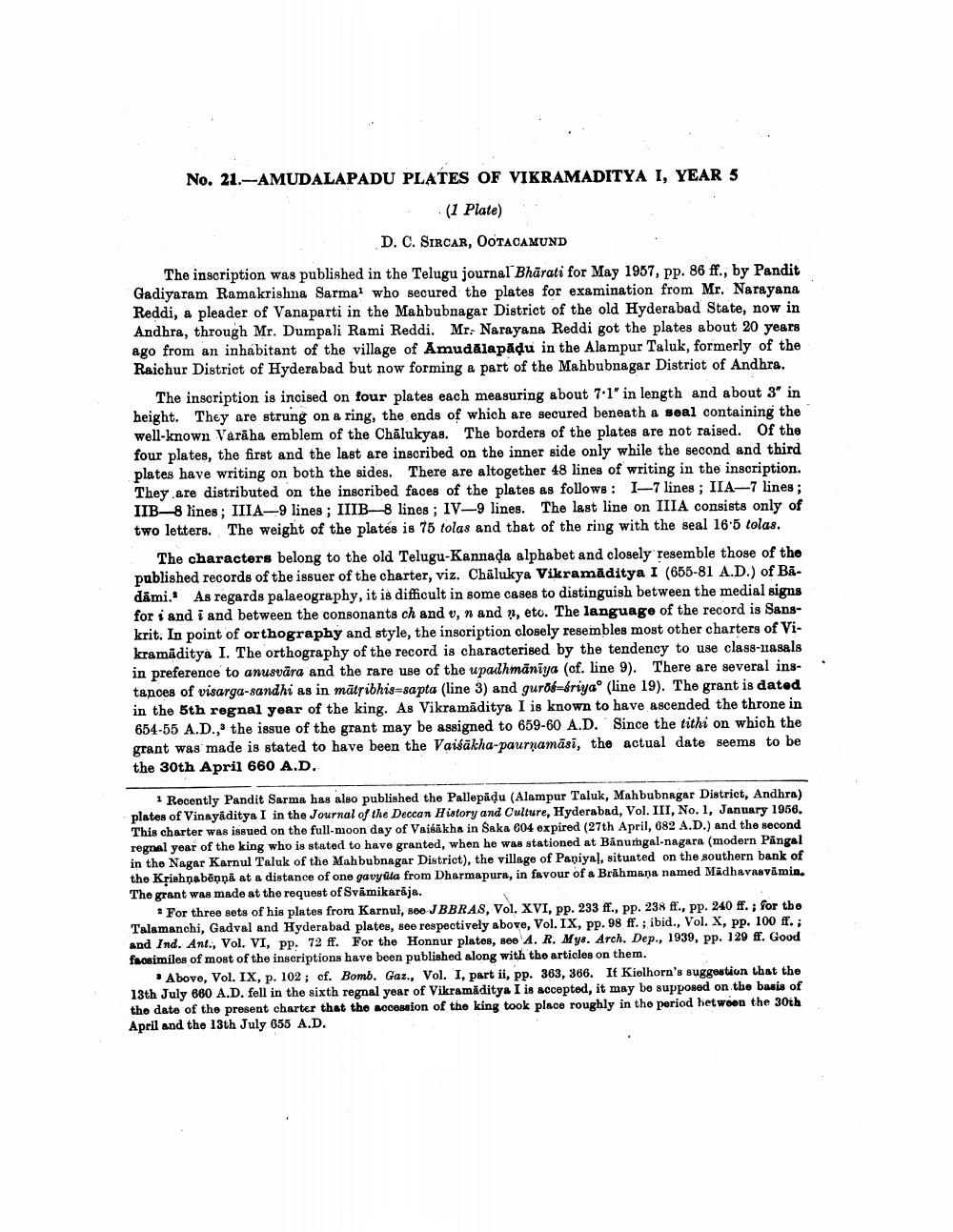________________
No. 21.-AMUDALAPADU PLATES OF VIKRAMADITYA I, YEAR 5
(1 Plate)
D. C. SIRCAR, OOTACAMUND
The inscription was published in the Telugu journal Bharati for May 1957, pp. 86 ff., by Pandit Gadiyaram Ramakrishna Sarma1 who secured the plates for examination from Mr. Narayana Reddi, a pleader of Vanaparti in the Mahbubnagar District of the old Hyderabad State, now in Andhra, through Mr. Dumpali Rami Reddi. Mr. Narayana Reddi got the plates about 20 years ago from an inhabitant of the village of Amudalapadu in the Alampur Taluk, formerly of the Raichur District of Hyderabad but now forming a part of the Mahbubnagar District of Andhra.
The inscription is incised on four plates each measuring about 7-1" in length and about 3" in height. They are strung on a ring, the ends of which are secured beneath a seal containing the well-known Varaha emblem of the Chalukyas. The borders of the plates are not raised. Of the four plates, the first and the last are inscribed on the inner side only while the second and third plates have writing on both the sides. There are altogether 48 lines of writing in the inscription. They are distributed on the inscribed faces of the plates as follows: I-7 lines; IIA-7 lines; IIB-8 lines; IIIA-9 lines; IIIB-8 lines; IV-9 lines. The last line on IIIA consists only of two letters. The weight of the plates is 75 tolas and that of the ring with the seal 16.5 tolas.
The characters belong to the old Telugu-Kannada alphabet and closely resemble those of the published records of the issuer of the charter, viz. Chalukya Vikramaditya I (655-81 A.D.) of Badami. As regards palaeography, it is difficult in some cases to distinguish between the medial signs for i and i and between the consonants ch and v, n and n, etc. The language of the record is Sanskrit. In point of orthography and style, the inscription closely resembles most other charters of Vikramaditya I. The orthography of the record is characterised by the tendency to use class-masals in preference to anusvära and the rare use of the upadhmaniya (cf. line 9). There are several instances of visarga-sandhi as in matribhis-sapta (line 3) and guros-ériya (line 19). The grant is dated in the 5th regnal year of the king. As Vikramaditya I is known to have ascended the throne in 654-55 A.D., the issue of the grant may be assigned to 659-60 A.D. Since the tithi on which the grant was made is stated to have been the Vaisakha-paurṇamāsi, the actual date seems to be the 30th April 660 A.D.
1 Recently Pandit Sarma has also published the Pallepäḍu (Alampur Taluk, Mahbubnagar District, Andhra) plates of Vinayaditya I in the Journal of the Deccan History and Culture, Hyderabad, Vol. III, No. 1, January 1956. This charter was issued on the full-moon day of Vaisakha in Saka 604 expired (27th April, 682 A.D.) and the second regnal year of the king who is stated to have granted, when he was stationed at Bänumgal-nagara (modern Pangal in the Nagar Karnul Taluk of the Mahbubnagar District), the village of Paniyal, situated on the southern bank of the Krishnabēņņa at a distance of one gavyuta from Dharmapura, in favour of a Brahmana named Madhavasvamin. The grant was made at the request of Svämikarāja.
For three sets of his plates from Karnul, see JBBRAS, Vol. XVI, pp. 233 ff., pp. 238 ff., pp. 240 ff.; for the Talamanchi, Gadval and Hyderabad plates, see respectively above, Vol. IX, pp. 98 ff.; ibid., Vol. X, pp. 100 ff.; and Ind. Ant., Vol. VI, pp. 72 ff. For the Honnur plates, see A. R. Mys. Arch. Dep., 1939, pp. 129 ff. Good facsimiles of most of the inscriptions have been published along with the articles on them.
Above, Vol. IX, p. 102; cf. Bomb. Gaz., Vol. I, part ii, pp. 363, 366. If Kielhorn's suggestion that the 13th July 660 A.D. fell in the sixth regnal year of Vikramaditya I is accepted, it may be supposed on the basis of the date of the present charter that the accession of the king took place roughly in the period between the 30th April and the 13th July 655 A.D.




